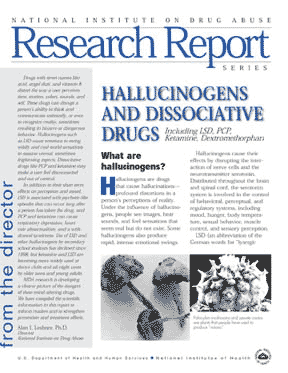NIDA has issued a new report summarizing recent scientific research on hallucinogens and other mind-altering drugs that distort perceptions of reality. The eight-page Research Report, "Hallucinogens and Dissociative Drugs," describes the drugs, explains how they work, and details how they impair users' ability to think, act, and communicate. Following are highlights from the report:
What are hallucinogens?
Hallucinogens cause hallucinations, profound distortions in a person's perception of reality. Users see images, hear sounds, and feel sensations that seem real but do not exist. LSD (lysergic acid diethlyamide) is the most potent mood- and perception-altering drug known and the most widely used hallucinogen. Other hallucinogens, including mescaline, psilocybin, and ibogaine, have actions and effects similar to those of LSD.

What are LSD's effects?
LSD's effects typically are felt within 30 to 90 minutes after ingestion and may last as long as 12 hours. The drug's effects, which are unpredictable and vary with the user's personality, mood, expectations, and surroundings, may include:
- Physiological effects: Increased blood pressure and heart rate, dizziness, loss of appetite, dry mouth, sweating, nausea, numbness, and tremors.
- Emotional effects: Rapid shifts through a range from fear to euphoria, so the user seems to experience several emotions simultaneously.
- Sensory effects: Highly intensified colors, smells, sounds, and other sensations. Changing perceptions of sensations, so the person may seem to hear colors and see sounds.
- Hallucinations: Distortions or transformations in shapes and movements. Perceptions that time is moving very slowly or that the user's is changing shape.
- Long-term effects: Persistent psychotic states, impairment of the capacity to recognize reality, think rationally, or communicate. Hallucinogen persisting perception disorder, commonly referred to as "flashbacks," which consists of spontaneous, repeated recurrences of some sensory distortions originally produced by LSD.
What are dissociative drugs?
Dissociative drugs, such as PCP (phencyclidine) and ketamine, were initially developed as general anesthetics. They distort perceptions of sight and sound and produce feelings of detachment but do not typically produce hallucinations.
What are the effects of PCP and ketamine?
PCP. In its common powdered form, PCP may be snorted or sprinkled on marijuana, tobacco, or parsley and smoked. Effects are felt within minutes of ingestion, may last for several hours, and are unpredictable. At low doses, physiological effects may include shallow, rapid breathing, increased blood pressure and heart rate, and elevated temperature. At higher doses, dangerous changes can occur in blood pressure, heart rate, and respiration, often with nausea, blurred vision, dizziness, and decreased awareness of pain.
Ketamine. Available illegally in powder or pill form, ketamine is similar to, though less potent and shorter acting than, PCP. The drug is odorless and tasteless, induces amnesia, and cannot be detected in beverages. It is sometimes used in commission of sexual assaults referred to as "drug rape."